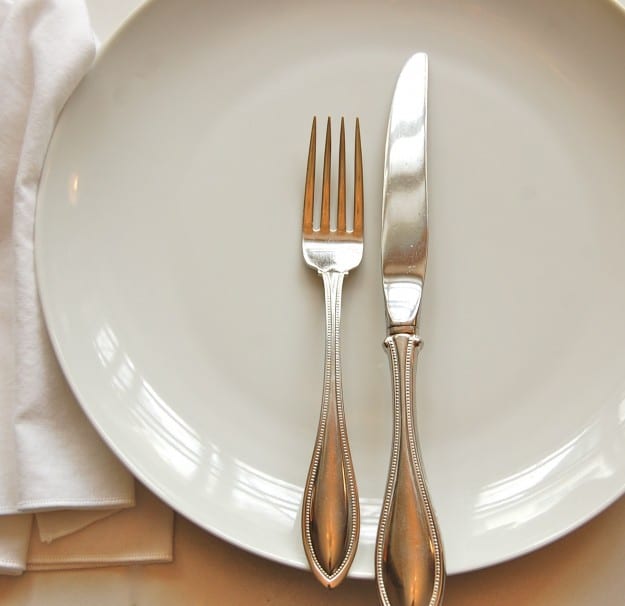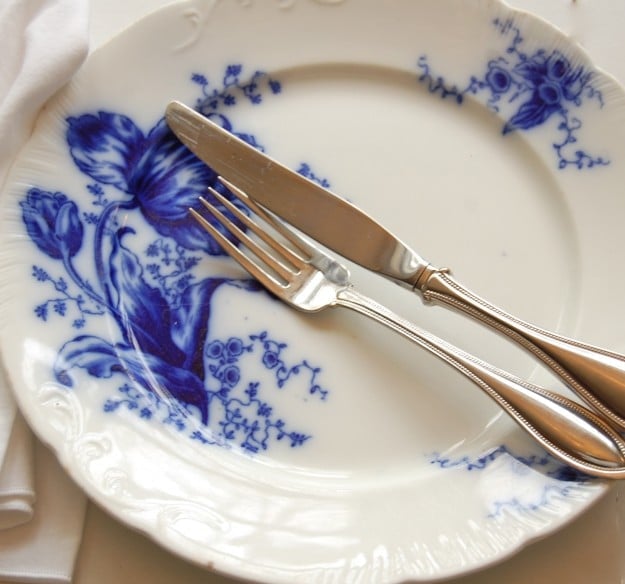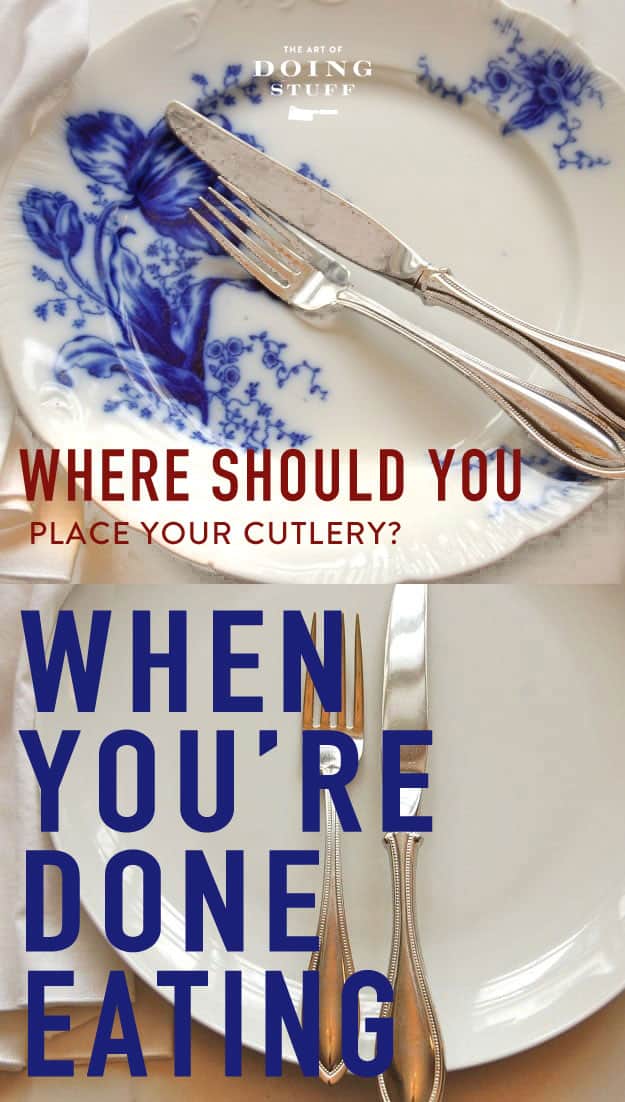You're out to dinner, you've finished your meal, now what? According to etiquette, where do you put your cutlery when you're done eating? You have two proper options and here they are.

Picture it. You're out for dinner and you've finished with your meal. You're done. At home, you'd simply stand up and wander away from the table knowing full well the dish would disappear, get clean and be returned to the cupboard at some point in the evening.
That's how it worked for my father anyway.
But in restaurants they like non-verbal clues. Indications that they can take your dirty plate away. A sign language of sorts. The waiter or waitress reads the secret code spelled out through your dirty utensils and napkin.
If the waiter doesn't happen to see you licking your plate (which is the International sign of "Yup ... thems was good eatin'. I'm done!") how are they supposed to know if you're finished eating?
They know by where you've placed your cutlery. Honestly, they do.
Where do you put your cutlery when you've finished eating?
![]()

![]()

The knife and fork go either straight up and down in the centre of the plate with the handles resting on the rim, or pointing between 10 and 4 o'clock. In each case the tines of the fork should be facing up, and the knife edge pointing in.
Your napkin should be half heartedly folded to the left of your plate.
Do NOT rest the cutlery on the table.
Do NOT cross the cutlery over each other in an X.
Do NOT put your napkin on your plate.
Do NOT perfectly refold your napkin.
Do NOT put your napkin on your chair.
Do NOT fold your napkin into the shape of a swan or a dead chicken and then leave the restaurant wearing it as a hat.
You are now fully prepared to attend the Royal Wedding. Have fun.
→Like to Sweat, Swear and do Stuff? GET MY POSTS emailed to you 3 times a week←






for desert you have a small folk and spoon above your plate and I want to know which way the folk and spoon should face
Your post has been very helpful and thanks a lot for sharing.
This is a quite interesting and informative piece you've shared here. I am glad I came across this blog post and actually I think I will bookmark this blog to get more updates. Thanks for wonderful article here. You're an incredible writer. Actually, I wrote an article on Toxicwap Movie and will be glad if you can check it using the link below https://www.techshure.com/coolmoviez/
Well, shoot. I've been placing my utensils at 8 & 2 when I'm finished, instead of 10 & 4. I guess I'm just a left-handed heathen.
Pretty sure I'm doing everything else right, now if I could just get the garden soil out from under my fingernails before my next dinner date...
Why should the napkin be placed on the left rather than the right side of the plate when you have finished eating?
Having a simple convention makes the work of the waiters easier, and that helps all around. Too often people just assume it’s their job, and don’t realise how hard that job is made by lazy customers, or customers with different ideas about how things should be done. It’s a simple matter to put your napkin on the left when done, then the waiter can have a safe, quick and reliable routine to clear the table quickly.
I always forget the rules about cutlery when it comes to fine dining, so I appreciated the reminders in your article. It's helpful to know that cutlery ought to be between the 10 and 4 o'clock positions on your plate when you're finished. I think it's the little things like non-verbal communication that really make a difference when it comes to fine dining.
I've been told that placing the fork upside down is a no-no, but I was taught by a very proper English lady whose parents had been in service, that the reason for placing the fork upside down is to allow the egg yolk to drip off the silver and on to the plate. Makes sense to me.
For about 3 years, back in the early 80s I was a full-time waitress in a couple of different restaurants in Toronto (trip down memory lane with me... Rhodes @ Yonge & St Clair, The Corner Bistro @ King and Bathurst). Anyway... I learned a lot at an early age by having these jobs, things I never would have learned in the home of my childhood. I'm forever grateful. I loved non-verbal clues because I was trying to be efficient without interrupting the guests' conversation.
A personal pet peeve I have is when the waiter comes by and removes one (or more) plate while others are still eating. They think they're being efficient but I was taught this is a real no-no as it's a subtle way of rushing guests to finish. Makes sense! I have to admit though, I'm not always at the fanciest places :(
My mother believed in doing everything "properly", so she taught me these rules of etiquette. I don't always follow her example, but I am aware. Unfortunately, not all wait staff are so aware.
While dining out this Mother's Day, I requested a spoon (not included in the table setting), and the server placed (smacked?) it directly onto my plate, not on the table. Very odd.
I guess it all depends on the waitstaff's knowledge of such things. Some are seriously lacking the basic skills that a server should have. I remember going to a restaurant in your neck of the woods, ordering a bottle of wine, and the server brought it to the table already opened and poured into glasses. I explained that it's customary to bring the sealed bottle to the table and open it there and have the customer taste it. Apparently she didn't know how to use a corkscrew, so the bartender opened it and poured it. We can only hope that it was the actual wine we ordered.
Thank goodness this is one '1st world problem' we don't have to worry about. In our house, we eat with our fingers, as many different cultures do!
(Then we wipe our mouths on the table cloth...just kidding!) :)
One of my best memories from my childhood was Sunday Dinners at home. The China, silver, napkins and delicious food all came out! And it was a way to teach and reinforce manners, a tradition I kept with my children, I was taught 10/4, not crossed, tunes down to preserve the silverware. On a side note, my 18 yr old son and I were at the doctors, other patients were almost all elderly and it was getting quite packed, another elderly woman came in, registered and couldn’t sit as there were no chairs, without a word or signal from me he jumped up and offered his seat, so proud of him!
If you do a halfway decent job of bringing them up, they'll do that, Thera. I remember being grossed out by both my son and my daughter on a regular basis, by their dedication to eating things for a dare or a bet (fifty pee if you lick it, one pound fifty if you eat the whole thing) and then amazed and gratified by comments from parents who had hosted play dates or sleepovers to the effect that my children were respectful, courteous and helpful, with "lovely manners".
Manners maketh the Man.
I love reading all the old comments. We get ourselves into such a lather, sometimes, eh? I eat out a fair bit (lots and lots of times just a Subway sandwich taken home, but I digress.) and I cannot for the life of me remember how I place my utensils. My favorite establishment knows me well enough to sense when I am *finished*, (yeesh, calm down, Mary!) and always asks if I would like the plate removed. Somehow in all my years, I've learned some good manners. Except I eat much too fast. I've eaten lunch in 5 minutes or so, during my 48 years as a hairstylist, and cannot seem to slow down very much. Happy Royal Wedding Watching, everyone. I'll have a nice Yorkshire Pudding in honor!
Interesting read. Etiquette is about being courteous and kind to the waiter (or whoever would clear the table at home). When one considers such things as cleanliness, unspoken communication and the like, all manners are an expression of empathy.
There are some small differences in culture, though. For example, in China, although you do place your chopsticks on the plate/bowl when you are finished eating, you do not place them in a direction pointing towards anyone else at the table. Even then, such a practice makes intuitive sense.